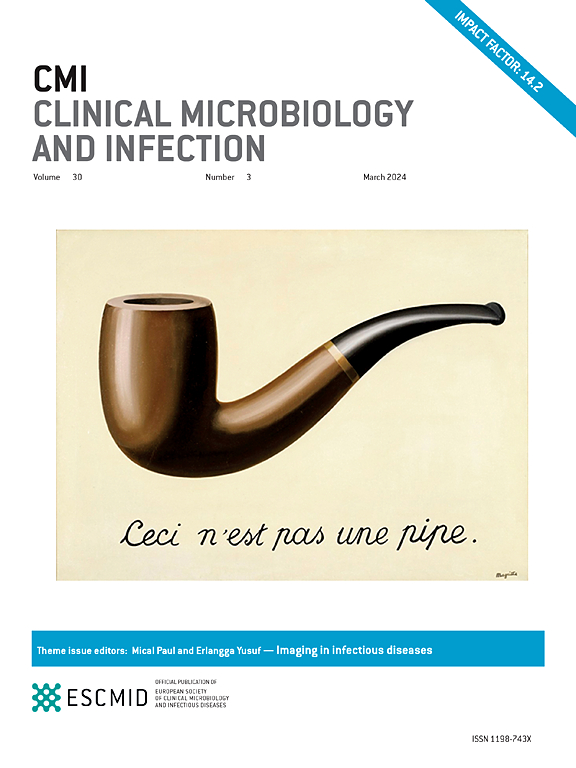Cefazolin vs. antistaphylococcal penicillins for the treatment of methicillin-susceptible Staphylococcus aureus bacteraemia: a systematic review and meta-analysis
IF 8.5
1区 医学
Q1 INFECTIOUS DISEASES
引用次数: 0
Abstract
Background
There is debate on whether cefazolin or antistaphylococcal penicillins should be the first-line treatment for methicillin-susceptible Staphylococcus aureus (MSSA) bacteraemia. Ongoing trials are investigating whether cefazolin is non-inferior to (flu)cloxacillin, but it remains uncertain whether these findings apply to other antistaphylococcal penicillins.
Objectives
We conducted a systematic review and meta-analysis comparing cefazolin with each of the individual antistaphylococcal penicillins for MSSA bacteraemia.
Methods
Data sources: We updated a 2019 systematic review but specifically focused on evaluating outcomes by individual antistaphylococcal penicillins.
Study eligibility criteria
Study eligibility criteria include comparative observational studies.
Participants
Participants include patients with MSSA bacteraemia.
Interventions
Interventions include cefazolin vs. the antistaphylococcal penicillins.
Assessment of risk of bias
Assessment of risk of bias involved the risk of bias in non-randomized studies of interventions tool.
Methods of data synthesis
The primary outcome was 30-day all-cause mortality and we assessed for non-inferiority of cefazolin using a pre-specified non-inferiority margin of a pooled OR <1.2 using raw unadjusted data. Secondary outcomes were 90-day mortality, treatment-related adverse events (TRAEs), discontinuation due to toxicity, and nephrotoxicity.
Results
No randomized data have been published. A total of 30 observational studies at moderate or high risk of bias were included, which comprised 3869 patients who received cefazolin and 11 644 patients who received antistaphylococcal penicillins (flucloxacillin = 6721, unspecified = 2440, nafcillin = 1305, cloxacillin = 1258, and oxacillin = 120). Cefazolin was associated with a reduced odds of 30-day all-cause mortality (OR = 0.73, 95% CI: 0.62–0.85) compared with antistaphylococcal penicillins, meeting pre-specified non-inferiority. This effect was consistent vs. flucloxacillin (OR = 0.92, 95% CI: 0.73–1.16), nafcillin (OR = 0.58, 95% CI: 0.28–1.17), cloxacillin (OR = 0.42, 95% CI: 0.11–1.58), and oxacillin (OR = 0.31, 95% CI: 0.03–2.75). Point estimates favoured cefazolin for 90-day mortality, TRAEs, nephrotoxicity, and discontinuation due to toxicity overall and in each comparison with individual antistaphylococcal penicillins, except for TRAEs vs. cloxacillin.
Discussion
In moderate-to low-quality observational data, cefazolin was non-inferior for mortality and potentially superior for safety as compared with antistaphylococcal penicillins overall and across most individual comparisons.
头孢唑林与抗葡萄球菌青霉素治疗甲氧西林敏感金黄色葡萄球菌菌血症:系统回顾和荟萃分析。
背景:甲氧西林敏感金黄色葡萄球菌(MSSA)菌血症的一线治疗是头孢唑林还是抗葡萄球菌青霉素存在争议。正在进行的试验正在调查头孢唑林是否优于(流感)氯西林,但仍不确定这些发现是否适用于其他抗葡萄球菌青霉素。目的:我们进行了一项系统综述和荟萃分析,比较头孢唑林和每一种抗葡萄球菌青霉素治疗MSSA菌血症。我们更新了2019年的系统评价,但特别关注于评估单个抗葡萄球菌青霉素的结果。研究资格标准:比较观察性研究。参与者:MSSA菌血症患者。头孢唑林对抗葡萄球菌青霉素的干预。偏倚风险评估干预工具的非随机研究的偏倚风险。主要结局是30天全因死亡率,我们使用预先指定的合并优势比(OR)的非劣效性裕度评估头孢唑林的非劣效性。纳入30项中等或高偏倚风险的观察性研究,其中3869例头孢唑林患者和11644例抗葡萄球菌青霉素患者(氟氯西林=6721,未指定=2440,nafcillin=1305, cloxacillin=1258, oxacillin=120)。与抗葡萄球菌青霉素相比,头孢唑林与30天全因死亡率降低相关(OR=0.73, 95%CI=0.62-0.85),符合预先规定的非劣效性。与氟氯西林(OR=0.92, 95%CI=0.73-1.16)、萘氟西林(OR=0.58, 95%CI=0.28-1.17)、氯氯西林(OR=0.42, 95%CI=0.11-1.58)和苯唑西林(OR=0.31, 95%CI=0.03-2.75)相比,这种效果是一致的。在90天死亡率、trae、肾毒性和因总体毒性引起的停药方面,以及与单个抗葡萄球菌青霉素(trae与氯西林除外)的每次比较中,点估计都倾向于头孢唑林。结论:在中等到低质量的观察数据中,与抗葡萄球菌青霉素类药物相比,头孢唑林在总体和大多数个体比较中死亡率不低,在安全性方面可能更高。
本文章由计算机程序翻译,如有差异,请以英文原文为准。
求助全文
约1分钟内获得全文
求助全文
来源期刊
CiteScore
25.30
自引率
2.10%
发文量
441
审稿时长
2-4 weeks
期刊介绍:
Clinical Microbiology and Infection (CMI) is a monthly journal published by the European Society of Clinical Microbiology and Infectious Diseases. It focuses on peer-reviewed papers covering basic and applied research in microbiology, infectious diseases, virology, parasitology, immunology, and epidemiology as they relate to therapy and diagnostics.

 求助内容:
求助内容: 应助结果提醒方式:
应助结果提醒方式:


